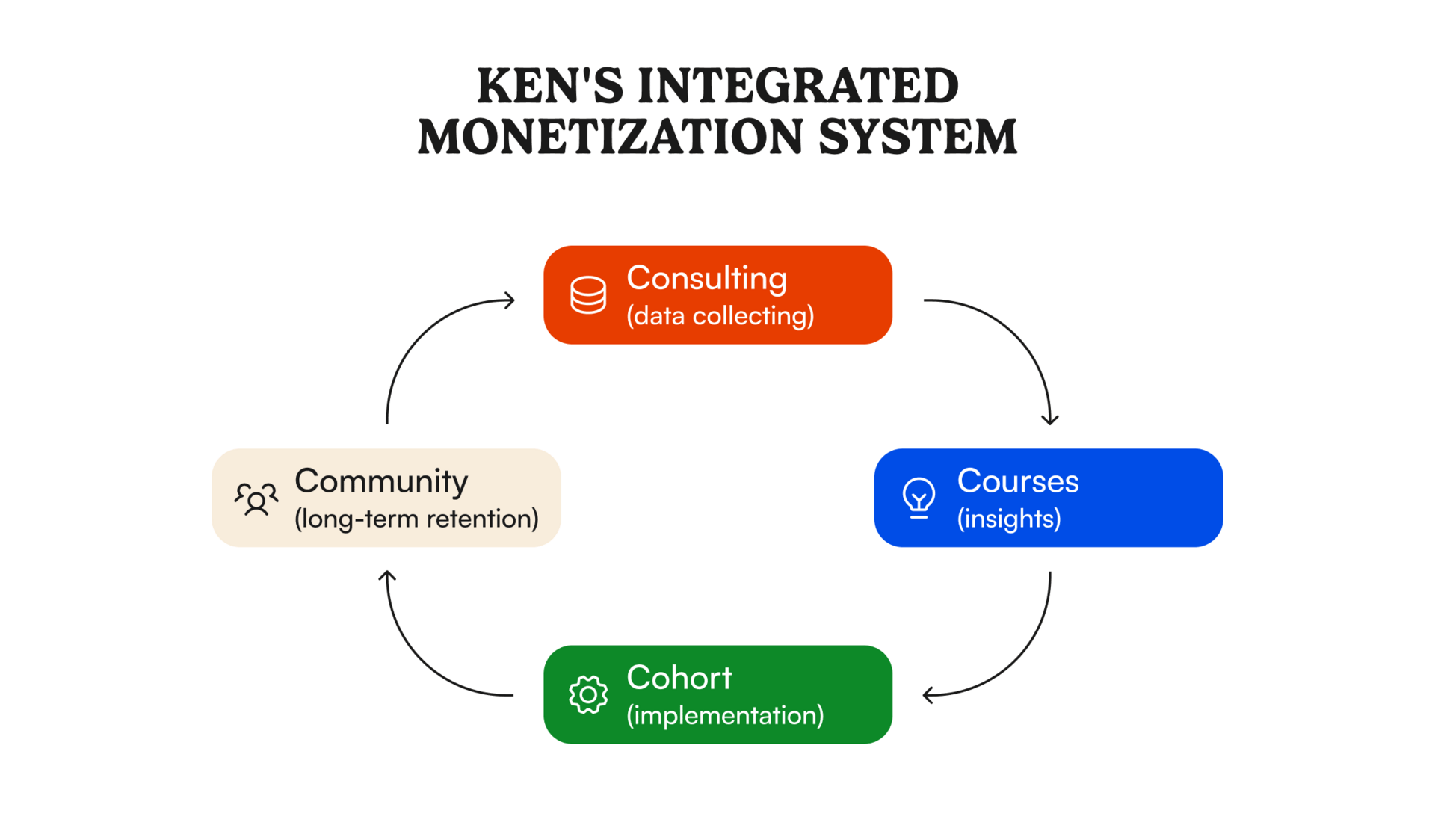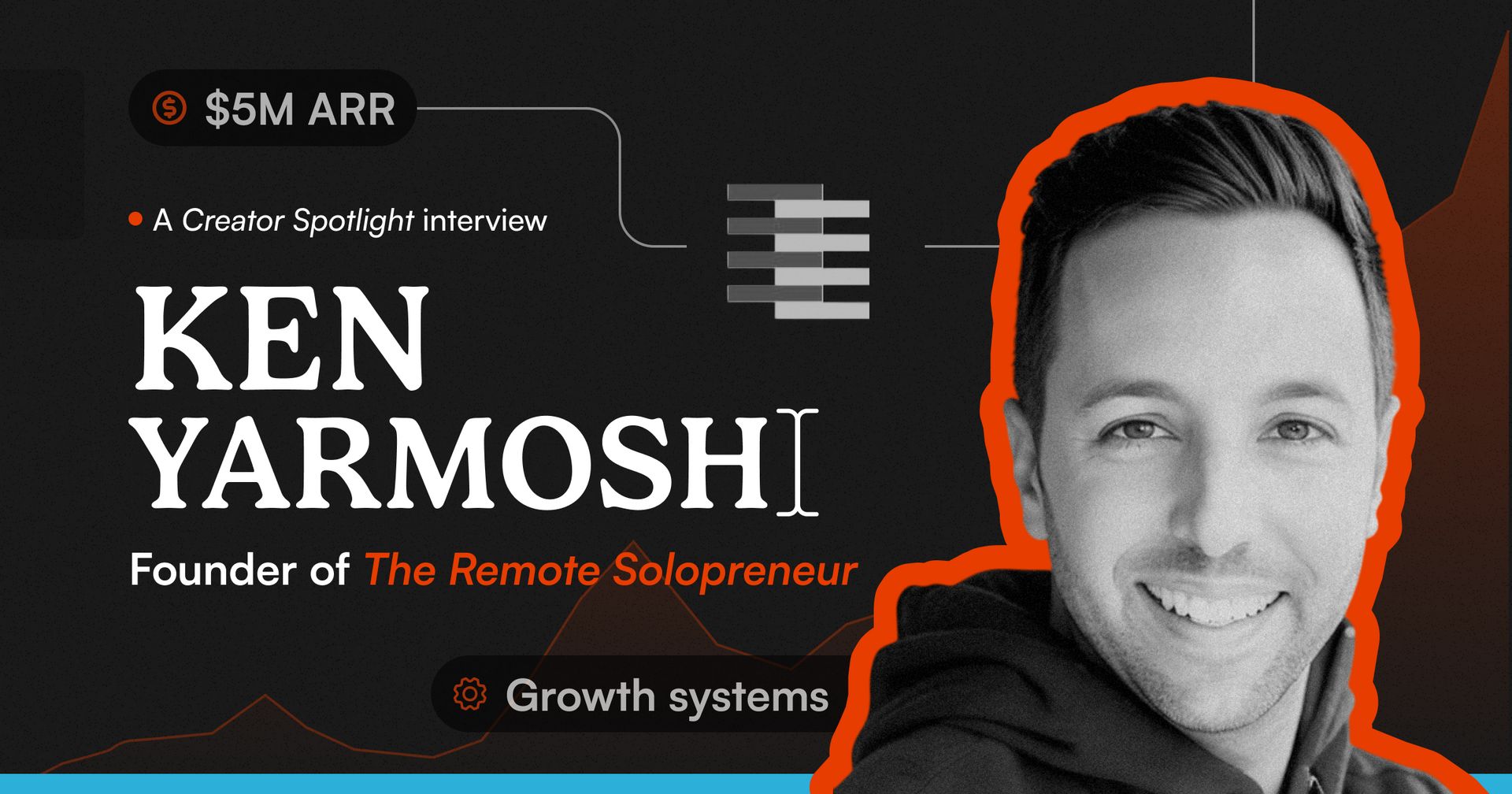Ken Yarmosh works with founders as a business advisor, speaker, and author, helping them build operations that scale through systems and documented processes rather than headcount.
He calls himself The Remote Solopreneur — even owns the domain.
In this episode:
💰 The “Four C’s” revenue flywheel for solopreneuers
🔄 How to adapt across platforms without losing momentum
🎯 Building depth with the right audience over building mass audience
— Natalia Pérez-González, Assistant Editor

00:00 Introducing Ken Yarmosh
01:16 Becoming The Remote Solopreneur
04:29 Redefining 'creator'
08:20 The creator-to-entrepreneur spectrum
12:15 How Ken runs a solo business
16:51 The importance of community in business
22:13 The 4 C's of the creator economy
29:42 Are all creators solopreneurs?
34:50 DTA: The framework for all entrepreneurs
41:58 Is the LinkedIn gold rush over?
47:15 The best time to be a creator is now
50:11 Advice for newsletter creators
53:20 Creating a personal brand in 2025
🎧 If you prefer a podcast platform other than YouTube, we’re on Apple, Spotify, and all the rest.
We make your niche make money
Your content might speak to a niche. Maybe it’s true crime podcasts for cats. Or even artisanal hot sauce reviews. We love it all.
The point is, no matter how specific your audience is, Google AdSense finds advertisers who actually want to reach them. It’s one of the largest ad networks in the world, which means someone, somewhere, is ready to pay to sponsor your oddly specific traffic (that means you, Albanian real estate bloggers).
That’s why sites like Hooda Math and WikiHow trust Google AdSense. Because even your niche deserves global attention—and better ads.
This is an advertisement.

Monetizing expertise, building systems
Ken Yarmosh has been uploading content to the internet since making a webpage required hard-coding with HTML. Over the last two decades, he's developed sharp instincts for building systems, pivoting between platforms, and monetizing expertise without scaling headcount. He identifies as a "remote solopreneur" — a term he owns, literally — he has the domain.
For Ken, being a solopreneur isn’t about working alone (at one point, he had 25 people on his payroll) but about prioritizing and scaling systems and documented processes, independent of specific roles and people.
The through-line across Ken’s career as a solopreneur has been adaptation. When a platform saturates or declines, Ken moves to where his audience is heading next.
Positioning for AI search discovery
Ken's current focus is on helping founders and creators build businesses that don't collapse when platform algorithms shift. His own business model illustrates this principle in action — he's now signing five-figure deals from clients who discover him through AI search engines like Perplexity and Claude.
When somebody asks Claude or Perplexity "who can help me build scalable systems for my creator business," Ken's work surfaces because he's optimized for how AI aggregates and surfaces expertise, not by keyword stuffing or backlink building, but by publishing detailed frameworks like the Four C’s (see more below under Steal this Tactic), using consistent terminology across platforms, and demonstrating expertise through actual client results rather than generic advice.
He's positioning himself where decision-makers will look when they need the expertise he offers. That's the pattern that’s kept him afloat and ahead for 17 years — flow where attention moves, build systems that survive platform changes, and prioritize depth with the right audience over mass appeal.

Connect with Ken on LinkedIn.
Learn more about The Remote Solopreneur.
You deserve a bigger payday
Google AdSense connects your (oddly) specific audience to advertisers who actually cater to them. One line of code, global reach, and ads that make you more money. Even if you’re writing about 18th-century top hats.
This is an advertisement.

Ken’s integrated monetization system for creator businesses
Ken's work focuses on “The Four C's” —
Community
Courses
Cohorts
Consulting
Together, they compose a monetization flywheel in which each piece addresses the limitations of the others. Here's how to build it.
Start with consulting to validate what people actually need
Don't build courses or communities based on what you think people want. Start with consulting — direct, high-touch advisory work that forces you to solve real problems for real money.
Consulting reveals what clients truly need because you're not theorizing in a vacuum, you're documenting solutions that successfully solve client problems, and that documented expertise becomes your curriculum.
When someone emails asking for advice, Ken says, don't give it away for free. Book a paid consultation call and charge enough that it matters — $500, $1,000, $2,000, depending on your positioning. The paid conversation validates demand and generates cash while you're building everything else.
More importantly, track the patterns across consultations. When three clients ask about the same problem, that's your signal to package the solution into something scalable.
Turn validated solutions into courses
Once you have your curriculum, extract those solutions into a course — or what Ken calls an "offer magnet,” a tool to identify who needs deeper help.
Ken ran a course called “Scalable Service Offers,” which at one point generated six figures in annual revenue. His secret wasn't the course content itself, but what happened 24 hours after someone purchased.
He'd send a simple follow-up email: "Thanks for buying. What are you trying to accomplish with your offers right now?" That single touchpoint started more conversations, which converted to more consulting engagements, and ultimately more revenue.
The tactical move: if you already have a course, add this email to your sequence. If you don't have a course yet, wait until you've done at least 10 paid consultations on the same topic. Package those learnings, price it accessibly, then use it as a filter to identify serious buyers.

Add cohorts to solve the implementation gap
We’re all suffering from information overload. ChatGPT provides information instantly. Claude and Perplexity provide information instantly, too, but guidance for how to implement the information we’re consuming is what’s scarce.
Cohorts bridge this gap by combining three elements that work together:
Async content people can consume on their schedule, boosting efficiency without timezone constraints when serving clients globally.
Live sessions where you solve problems in real-time — what Ken calls "sweating on the mat together." Watching a YouTube video about fitness isn't the same as having someone next to you doing the work. The live element creates accountability that recorded content can't match.
Peer accountability, where participants keep each other moving forward between sessions.
Run your first cohort manually before automating anything. Start small, combine live sessions with async content, and charge enough to ensure commitment.
After one cohort, you'll know what content should be async, which problems require live attention, and how to structure the experience for scale.
Build community to extend lifetime value
The relationships formed within your cohort don’t need to end after the programming is done, and they shouldn’t. Cohorts should serve as the foundation for an ecosystem that lives beyond these initial connections.
Ken runs a 100-person Circle community he describes as a "virtual country club," and the emphasis on curation is everything: all people in this community are founders or operators at similar business stages who become genuine peers. People will keep paying for the relationships and collective expertise.
Never launch a community cold — in Ken’s case, a community serves as the overflow from cohorts and consulting, which means his first community members are people who've already paid him for something else. They're pre-vetted, invested, and more likely to engage because they've already experienced value from working with him.

The future of the creator economy is in-person (Creator Spotlight)
NBA launches ‘Creators Court’ to tap viral social media trends (SBJ)
The argument for letting AI burn it all down (WIRED)





